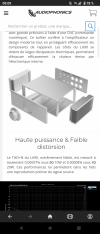in a blind preference test between a well calibrated
NAD T758 or MartinLogan Forte (which is a
Paradigm PW-AMP with better streaming support) and a “purist” magic SINAD signal chain with this amp, one should expect to lose money betting against the SINAD-fail AVR with Dirac Live or budget baby integrated with the latest Anthem Room Correction... however one ranks a super quiet low power low distortion
power amp, as an
integrated amp
one can’t sensibly consider this one better than headless failure
[emphasis mine]
I generally enjoy your posts and your youtube speaker reviews, but the bolded statement is lazy and uninsightful.
Whether you (we) like it or not, it goes without question that most stereos (and I mean in excess of 95%) in use today do not use any form of DSP/RC, so for most users, your assessment is of little value (if not meaningless). Moreover, the vast majority of integrated amps do not include DSP (in fact, other than the 2 you mentioned, you could probably name the rest without much difficulty), so in the context of the marketplace, not having DSP cannot be used as a metric for grading an amp as a "headless failure."
The aforementioned statement notwithstanding, let's now consider the argument embedded in your statement. This amp is a failure because it does not allow for room correction. Again, lazy thinking. There are many ways in which a user can address RC while also using this amp:
1. Use a PC as a source (one can even use Dirac in this context)
2. Use a source that provides DSP
3. Pass the source through electronics that provide DSP prior to reaching the amp (I have a MiniDSP that provides Dirac for any HDMI source, this can easily be converted to analog and fed to the amp)
3. Use speakers that have integrated DSP for the bass
4. Alternatively, and for many users this is a preference, take steps to correct room issues instead of using DSP.
So, if the concern is the need for room correction, then there are numerous ways of addressing this.
So, is the LA90 a laudable design? Its performance metrics outside of power output clearly place it amongst the best there is. However, should the amp not be described as borderline useless because of its power output? Let's consider the many ways in which this amp has sufficient power:
1. As a desktop amp
2. Powering speakers with efficiency above 93db
3. Used in rooms sizes commonly found in houses in Europe, Japan, and many condos in expensive cities in NA
4. Most bedrooms
5. Etc.
Yes, the amp's power output does not reach the needs of many users in this forum (I doubt it even meets my office needs) and elsewhere, but that is not the measure of the amp's utility. As noted above, there are many contexts under which LA90 provides sufficient power, the fact that it does not meet a particular group of consumers' needs should not be construed as an indictment of the design or the amp (it was never meant for such users), it merely means those consumers needs are better addressed by other designs/amps.

